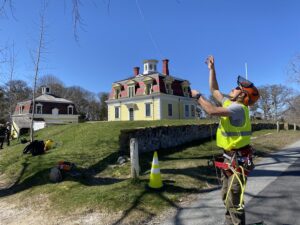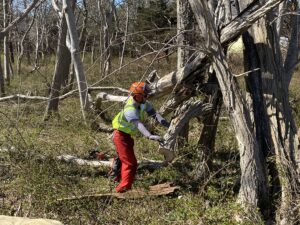EASTHAM — Most mornings, the grounds of the Penniman House at Fort Hill are a peaceful setting for birds, squirrels, and the occasional tourist. But on the morning of April 9, the historic building was surrounded by a crew of workers revving chain saws, driving trucks, raising a scissor lift, and hoisting themselves into cottonwoods.

The crew was composed of a handful of Cape Cod National Seashore staff and a team of 14 members of the Arborist Incident Response (AIR) team, a network of experienced arborists from National Park Service sites across the country. When there is need for specialized tree work, such as after a natural disaster or during extensive maintenance, the AIR team is sometimes called to address it.
“They’ll put a call out for the team, and whoever’s available will go,” said Dan McCarthy, chief of facilities for the Seashore and former program manager for the AIR program. The crew arrived on April 6 and will be working in locations across the Park until April 13. “They’re working 12-hour days when they’re here,” McCarthy said.
AIR arborists came to the Outer Cape from places as varied as the Statue of Liberty and Fire Island and as far away as Maine and Georgia. Their reason for visiting is an extensive maintenance project aimed at protecting historic structures from the dual threat of tree collapse and fire.
McCarthy said the team will focus on “hazard trees” — trees and branches that could fail and end up causing damage as they come down.
At the Penniman House, the main hazard trees are the pair of cottonwoods that stand over the house’s ocean-facing wall. The trees needed to be trimmed of their dead wood and damaged limbs — a job the AIR team, with its members’ extensive experience working in the canopies of trees, is well suited for, McCarthy said.
Cape Cod National Seashore staff do some work to prevent hazard trees from damaging their historic sites, but without extensive tree climbing experience, it can be challenging to do more than address problems as they arise, McCarthy said. The AIR team, he said, allows the park to get ahead of problems by removing potential hazards before they become dangerous.
Besides this work at the Penniman House, the crew will take on projects at Nauset Light in Eastham, the Atwood-Higgins House in Wellfleet, and the Jedidiah Higgins House in Truro, among other locations.

The other key aspect of the team’s work is fire suppression. CCNS abides by the Wildland-Urban Interface Code, a set of guidelines created by the International Code Council to prevent wildfires, said Michael Valora, chief ranger for the Seashore. These guidelines suggest reducing vegetation up to 100 to 150 feet around a building to minimize a property’s “fuel load,” Valora said.
At the Penniman House, the fuel load reduction involved removing all vegetation within 10 to 20 feet, McCarthy said, and further removing dead vegetation and fallen trees farther away from the house. While some AIR arborists were climbing trees, others were working in the surrounding vegetation to get the Penniman House grounds in line with the code.
This creates a so-called defensible space, McCarthy said, to keep wildfires contained and prevent them from approaching historic structures.
Creating defensible spaces is part of the Park’s fire management plan, said Valora. The plan was rewritten in 2022, he said, which led to the Park keeping extra staff on duty during last summer’s period of elevated fire danger.
Enacting the plan hasn’t been easy without David Crary, the former fire management officer at the Park, who retired in December 2021. Since Crary’s retirement, there has been no dedicated fire officer at the Seashore, according to Valora, although an effort to find an assistant fire management officer is underway — a process he said he hopes will conclude within the next several months.
There are also plans to perform a controlled burn near the Penniman house in the fall, according to an email from the Seashore’s Linzy French. The purpose will be to reduce the fuel load in the area and preserve the open space that was present when Capt. Edward Penniman had the house built in 1868 and the Knowles family farmed the land between Fort Hill and Skiff Hill to the north.
